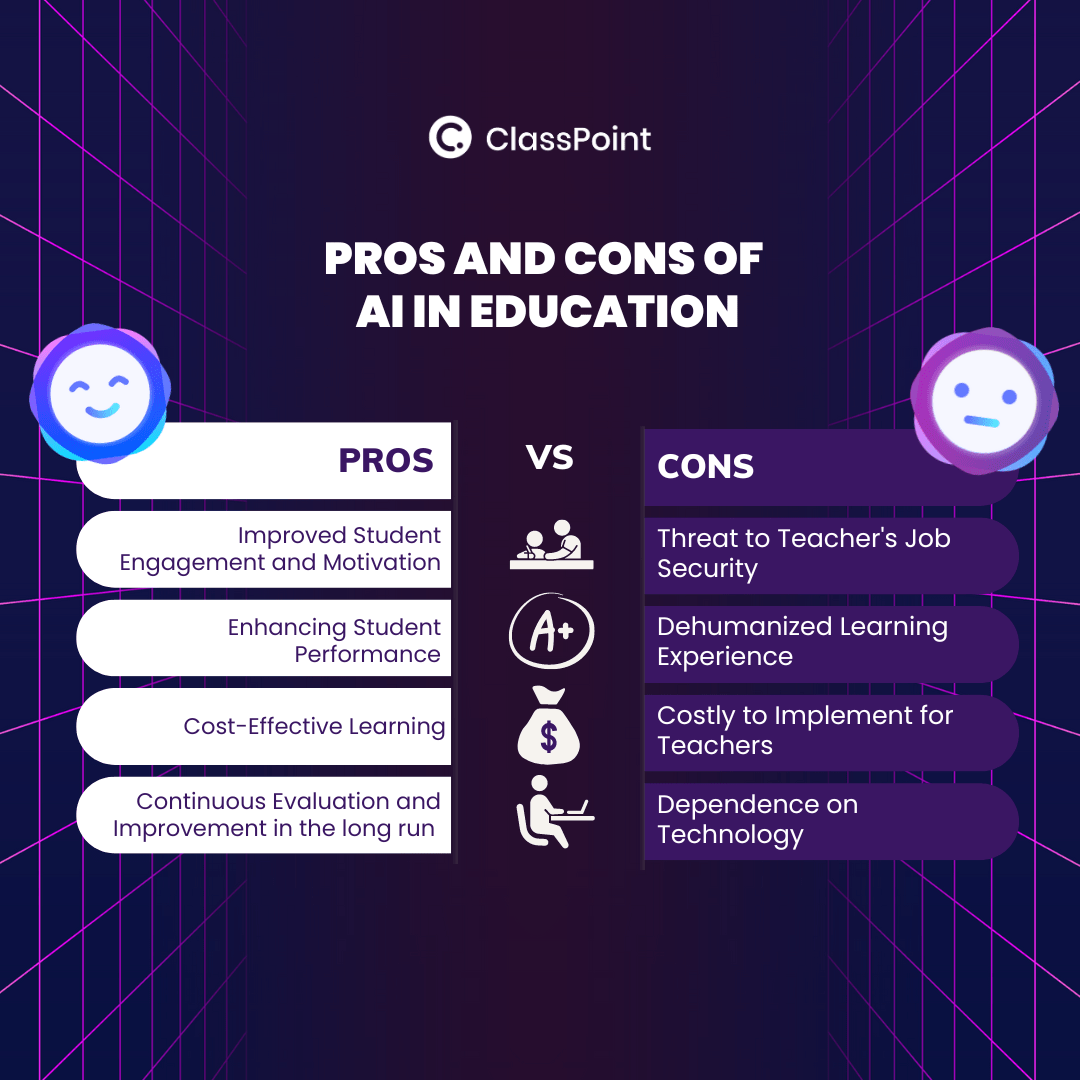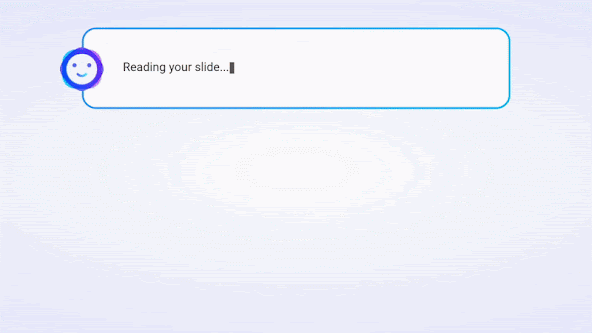The Pros and Cons of AI in Education and How it Will Impact Teachers in 2023
The future is indeed here. It has no doubt that Artificial Intelligence in education is gaining popularity among teachers and students. Educators use AI in the form of EdTech tools to aid them in creating lesson plans or computing students’ grades while as for the learners, AI can assist them to accomplish their projects, homework, and even research papers. While we can’t deny that Artificial Intelligence in 2023 is becoming a part of our lives now, there are still a couple of pros and cons of AI that need further attention and are still up for discussion. In this blog, we will help you to identify each of those pros and cons, and what important role should you be taking on to ensure AI usage for education is still in moderation. Lastly, we will weigh the advantages and disadvantages of AI and decide if teachers should incorporate the usage of AI in the form of EdTech tools in their teaching strategy.

The Advantages of AI in Education
In this modern world, integrating AI technology grows rapidly in education. AI is there to assist and make our day-to-day tasks lighter. With a proper prompt, any activity that you wish to get done will be accomplished in a matter of seconds. This is just one of the many Pros of AI, let’s discuss more!
1. Improved Student Engagement and Motivation
The use of AI applications in teaching can enhance the learning experience in many ways such as personalized learning exercises thanks to AI algorithms or instant feedback and communication thanks to AI natural language processing. AI can also be employed to enhance gamified learning which can further make learning enjoyable, engaging, and rewarding. Using AI tools can guide educators to use a more interactive teaching approach which may result in increased engagement and motivation in the class as well as improved learning objectives.
2. Enhancing Student Performance
Another significant pro of artificial intelligence in education is that it can help enhance student performance with increased feedback. AI-powered systems can evaluate students’ progress, provide them with targeted feedback, and identify areas where they need improvement. Moreover, AI can monitor students’ behavior patterns, assess their attention levels, and determine if they need additional assistance in certain subjects, granular areas, or specific skills. Instant, AI-powered feedback along will enhanced learning experiences can be expected to push students’ abilities to new heights.
3. Cost-Effective Learning
Using AI in Education can also reduce the cost of education from an educational institution’s perspective, and quite significantly if used to its potential. AI can automate a number of tasks assigned to administration, teachers, IT, and more. For example, AI can take on daily tasks such as grading, scheduling, data management, and even tutoring. With AI in education, educational institutions can save on budget by cutting down resources required to operate efficiently, thereby increasing cost-effectiveness.
4. Continuous Evaluation and Improvement in the long run
Last on our Pros of AI list is continuous evaluation and improvement. AI-powered EdTech tools can easily collect, analyze, and provide report data to teachers on student learning outcomes and behavior patterns. By using predictive analytics, AI can provide educators with valuable insights from predicting future performance, providing personalized interventions, early identification of at-risk students, and refining instructional strategies.
This useful information can enable educators to have a more in-depth evaluation in understanding their student’s strengths and weaknesses in the classroom. In addition, teachers can have the chance to take their teaching strategies to the next level and give the best learning experiences to their students.
How EdTech tools can contribute to an engaging and interactive class
We’re not new to the existence of EdTech or Educational Tools in terms of helping teachers to perform engaging and interactive activities in their classes. As a part of the Pros of AI in education, Let us dive more into how AI tools can be of service to educators and in what ways it can lighten their daily teaching needs.
Artificial intelligence in EdTech tools can serve as a teacher’s assistant, it saves time without sacrificing the quality of its output. One of the many good examples of a friendly AI-powered tool is ClassPoint AI. ClassPoint AI’s main goal is to ease every teacher’s workload in creating quizzes by effortlessly generating captivating questions from any PowerPoint slide in an instant. Built by a team of experts with a passion for education and technology, ClassPoint’s advanced AI technology carefully detects your PowerPoint slide and creates thought-provoking questions out of it.
Each and every EdTech tool out there has its own unique ways and features to aid teachers in anything that they need, that’s why we also covered 7 AI tools that every teacher can use in this modern era of 2023.
Cons and Challenges of AI in Education
For every single thing in this world to be balanced, one must have Pros and Cons, and AI is not an exception of it. What can become a challenge in AI that we can consider as cons? Let’s continue to identify.
1. Threat to Teacher’s Job Security
First on the list are the threats to teachers’ job security. This is not happening yet, but it is a concern that the advancement and adoption of AI could impact the need for certain job roles in education. The way AI continues to automate more aspects of the education process, there may be fewer demands for human educators, which could lead to both improved productivity and potential job loss.
2. Dehumanized Learning Experience
One of the biggest cons of AI in education is that it can dehumanize the learning experience. With AI algorithms generating content and deciding the pacing of the lessons, students may miss out on the nuanced approach that a human teacher can offer. Additionally, AI algorithms can perpetuate bias, meaning that they may fail to provide an inclusive and diverse curriculum that is tailored to the needs of every student.
3. Costly to Implement for Teachers
Another disadvantage of AI in education is that it can be costly to implement for teachers. Not all schools and educational institutions have a dedicated budget for investing in AI tools and technologies. Plus the cost of mass-implementing AI into schools may be too great at this time. If the teacher will be the one to shoulder the cost, it can be expensive, and challenging to maintain.
4. Dependence on Technology
As schools become increasingly reliant on AI-powered solutions, there is a risk that teachers and students may become too reliant on technology. In the long run, this dependence could result in the neglect of important traditional teaching methods and the development of critical thinking and problem-solving skills.
Human Intervention: The Roles of Teachers
Artificial intelligence is playing an increasingly significant role in transforming how students learn and how teachers instruct. However, as with any innovation, there are both pros and cons of AI when incorporating it into the classroom and when there are too many challenges happening in the class, this is where human intervention is set to come in.
Now the question is, what important role should teachers be taking to ensure AI usage for education among students is still in moderation?
- Teachers and AI can collaborate in co-teaching scenarios, where AI systems may assist in instruction, assessment, and real-time feedback & tutoring, while teachers offer guidance, interpretation, and deeper engagement with the material
- The role of teachers as mentors, motivators, and facilitators of learning will remain essential. Teachers bring human connection, empathy, social-emotional skills, and the ability to foster creativity and critical thinking, which cannot be replicated by AI.
- The teacher-AI collaboration will harness the power of technology while upholding the invaluable human elements of education.
As simple as it looks, teachers can still have the power to set rules and boundaries in class. Set a strict rule of prohibiting the usage internet in any face-to-face class activities and allow students to think freely and creatively using their gained knowledge from past lessons.
Given these pros and cons, it is also essential that EdTech companies and schools work together to create a balanced approach to AI in education. Teachers play a crucial role in this effort by understanding how to best integrate AI tools into their instruction, while still maintaining their core role as educators.
Time to Weight in! Is Using Artificial Intelligence in Education have more Pros or Cons?
As we’re nearing our conclusion, the Pros and Cons of AI are both intense; but as a teacher, should you restrict yourself from using AI for educational purposes? Definitely not. Our world is evolving, and we need to embrace that the power of Artificial Intelligence is likely to bring more benefits than harm, so you might want to expect its adoption not only in education but in every industry. We just have to learn to use it in moderation and set a good image for our students to not fully rely on Artificial Intelligence. Confidence in your expertise, trust in your skills, and better judgment is the key.
Nothing can still replace the emotions and compassion a human teacher has toward their students.
Ma. Theresa Ganaden, ClassPoint Philippines Community member
Conclusion
Overall, the evolving role of AI in education offers both opportunities and challenges for teachers. By being proactive in their approach to this technology, educators can leverage AI to improve student outcomes and promote equity in the classroom, while still preserving the unique role that teachers play in fostering growth, development, and learning in their students. That is why it is still necessary to incorporate the usage of AI-powered EdTech tools as a part of teachers’ teaching strategies.
With the help of ClassPoint AI, teachers wouldn’t need too much work on creating insightful quiz questions. ClassPoint AI is made to analyze teachers’ lesson slides and generate questions from it. It promotes a healthy balance of trusting the teacher’s expertise in any subject by purely relying on the information they wrote in the PowerPoint and working its magic in stimulating questions in just seconds.

Comments
Post a Comment